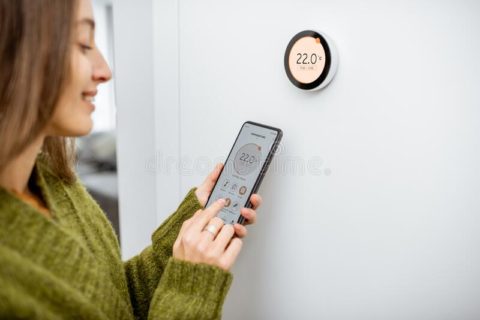Podcast: Play in new window | Download
Subscribe: RSS

This attractive young lady is programming her smart thermostat to destroy the world.
We made “smart” thermostats too smart: they’ve hatched a plot to take down the electric grid. (BTW: whenever you see the word “smart” attached to an inanimate thing, know that something really stupid is going on.)
Smart thermostats contain a timer that, during the heating season, lowers the temperature of the house a few degrees while its residents are most likely asleep, then returns it to the preset level by the time they arise for the day. Marketers assure householders that a smart thermostat can save them 30% on their energy costs. Reality is more like 5%. Nevertheless, the pitch has worked so well that 40% of all US households are now governed by a smart thermostat. That’s 50 million homes (as of 2020).Only after this had happened did anybody realize what the hitch was.
The default setting on smart thermostats for returning the house temperature to normal is 6:00 am. Any homeowner can change it, but few do. As a result, we now have millions of homes demanding surges of electricity at precisely 6:00 am. This spike in demand is an existential threat to the grid for at least two reasons:
- Any sudden demand on the grid must be foreseen and provided for in advance. If the generated electricity is not present when the switch is thrown, and demand exceeds supply, the grid’s voltage will drop, causing potentially severe damage to electric motors and electronics. That’s a brownout. If it lasts very long or gets very bad, automatic circuit breakers start taking down the grid in order to save it. That takes care of the demand problem, but restarting the grid or sections of it is a terribly complex task that can take days.
- The spike in demand that comes at 6:00 am in winter occurs before the sun is up or, usually, the wind has started to blow. So a major tool used by grid operators in daylight hours to cover demand spikes is not available to them. They have only the traditional generating sources — gas-fired, coal-fired, and nuclear. None of these generators can be ramped up or down quickly, so making sure they are churning out enough power to meet a future demand spike is an extremely costly — and polluting — proposition.
There are only two times the grid is threatened with being overwhelmed by demand — when it’s cold, and when it’s hot. Every year, because of global climate change, it is colder longer and hotter longer. Right now, dangerous heat waves grip large chunks of the American South, West and Midwest. Grids in Texas and California, especially, are on life support.
They are old, they are breaking down, and they require massive — and massively expensive — intervention if they are to survive much longer. This problem has been known by engineers, and relief has been promised by politicians, for decades. Indeed, the Biden Administration early on got a trillion-dollar infrastructure bill passed that promised to update the grid, expand generating capacity and make everything resistant to climate change. But the money allocated was far from adequate, and nearly two years later nothing of any significance has been started because of pushback from the states and lack of coordination among the feds.
The more things change, the more they are the same. We’re going to miss the grid when it’s gone. As they do in South Africa right now. And our last straw may well be that pesky “smart” thermostat in your “smart” house.
Now I feel bad for programming my kerosene heater. At least it doesn’t draw a lot of amps.
I’ve learned to mostly leave my small electric heaters on a constant low setting that’s tolerable rather than try to turn them off ever time I leave the house.
Simple and cheap programmable thermostats have been around for years, no need to add “smarts”, and less likely to all be defaulted to the same pattern.
A typical example, many others also available.
https://www.lowes.com/pd/Emerson-5-2-Day-Programmable-Thermostat/1000004548